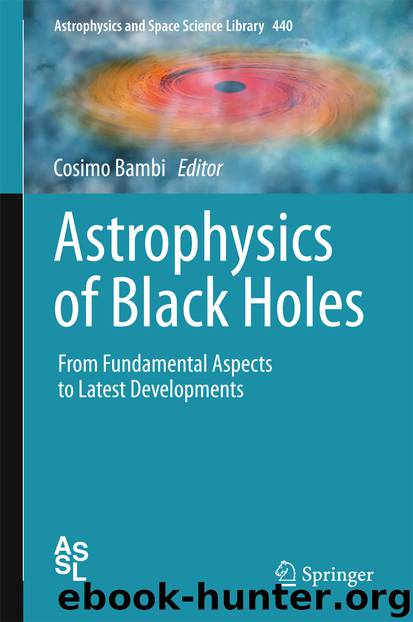Astrophysics of Black Holes by Cosimo Bambi

Author:Cosimo Bambi
Language: eng
Format: epub
Publisher: Springer Berlin Heidelberg, Berlin, Heidelberg
3.3.2 Modelling the Reflection Spectrum
A hard tail of emission ubiquitously accompanies the thermal disc emission in BHBs (and AGN—see, e.g. Jin et al. [138, 139]) and must originate by inverse Comptonisation in a corona of thermal/nonthermal plasma in some, as yet, undetermined geometry (e.g. Liang and Price [172]; Haardt et al. [118]). The exact spectral shape (and properties such as variability) of this component is discussed in detail elsewhere in this compilation but can very broadly (though not always accurately) be described by a power law which breaks at the peak temperature of the thermal electron distribution.
In all models, the corona producing the power law emission has a larger scale height than the disc, and as a consequence, the disc will subtend some solid angle to the upscattered seed photons which will re-illuminate the disc down to a typical scattering surface at = 1 (e.g. Guilbert and Rees [117]; Lightman and White [174]; George and Fabian [107]). The resulting ‘reflection’ spectrum is composed of scattered re-emission (i.e. Compton scattering in the surface layers), bound-free edges, bound-bound absorption and emission lines. The three most important components of the spectrum are the Fe K edge, the Fe K fluorescent line(s) and the Compton downscattered hump. The details of these components are discussed in detail in the review of Fabian et al. [85] with only a brief overview provided here.
As Fe is cosmically abundant and the fluorescent yield (the probability that a fluorescent line is produced following photoelectric absorption) of neutral elements scales as , emission from Fe is expected to be of great importance. Moderate energy (a few keV) X-ray photons produced via inverse Compton scattering in the corona are energetic enough to remove the inner K (1s) shell electron (leading to a sharp photoelectric edge at 7.1 keV). As long as electrons are available in the L (2s) shell, one will drop to fill the K shell gap and release a photon at either 6.404 keV (K) or via spin–orbit interaction, a secondary transition at 6.391 keV (K). The probability of this occurrence is only 34 %, whilst the most favoured (66 % probability) outcome is Auger de-excitation where the production of a photon via the LK shell transition is absorbed by a bound electron which is subsequently expelled. These energies assume that the Fe is neutral; however, illumination of the disc will act to increase the ionisation state of the reflecting material (e.g. Ross and Fabian [283]; Ross et al. [284]), parameterised as , where n is the electron density and r is the distance from the ionising source of luminosity L [322]. An increase in ionisation state increases the electron binding energy and the energy of the edge and Fe K fluorescent doublet accordingly; however, the lines only emerge significantly above 6.4 keV for Fe XVII and above. The fluorescent yield will also (weakly) depend on ionisation state, and when Fe is Li- through to H-like, Auger de-excitation is no longer possible as two L shell electrons are required. Instead, photoelectric recombination can lead to line emission (with a high fluorescent yield) at 6.
Download
This site does not store any files on its server. We only index and link to content provided by other sites. Please contact the content providers to delete copyright contents if any and email us, we'll remove relevant links or contents immediately.
Tools of Titans by Timothy Ferriss(7810)
Turbulence by E. J. Noyes(7700)
Astrophysics for People in a Hurry by Neil DeGrasse Tyson(5000)
Secrets of Antigravity Propulsion: Tesla, UFOs, and Classified Aerospace Technology by Ph.D. Paul A. Laviolette(4989)
Design of Trajectory Optimization Approach for Space Maneuver Vehicle Skip Entry Problems by Runqi Chai & Al Savvaris & Antonios Tsourdos & Senchun Chai(4839)
Room 212 by Kate Stewart(4732)
Pale Blue Dot by Carl Sagan(4613)
The David Icke Guide to the Global Conspiracy (and how to end it) by David Icke(4377)
A Journey Through Divination and Astronomy by Publishing Pottermore(4248)
Apollo 8 by Jeffrey Kluger(3512)
Goodbye Paradise(3444)
Losing the Nobel Prize by Brian Keating(3424)
COSMOS by Carl Sagan(3346)
The Five People You Meet in Heaven by Mitch Albom(3334)
How to Read Water: Clues and Patterns from Puddles to the Sea (Natural Navigation) by Tristan Gooley(3239)
Brief Answers to the Big Questions by Stephen Hawking(3239)
How to Read Nature by Tristan Gooley(3077)
The Order of Time by Carlo Rovelli(3073)
A Brief History of Time by Stephen Hawking(2819)
